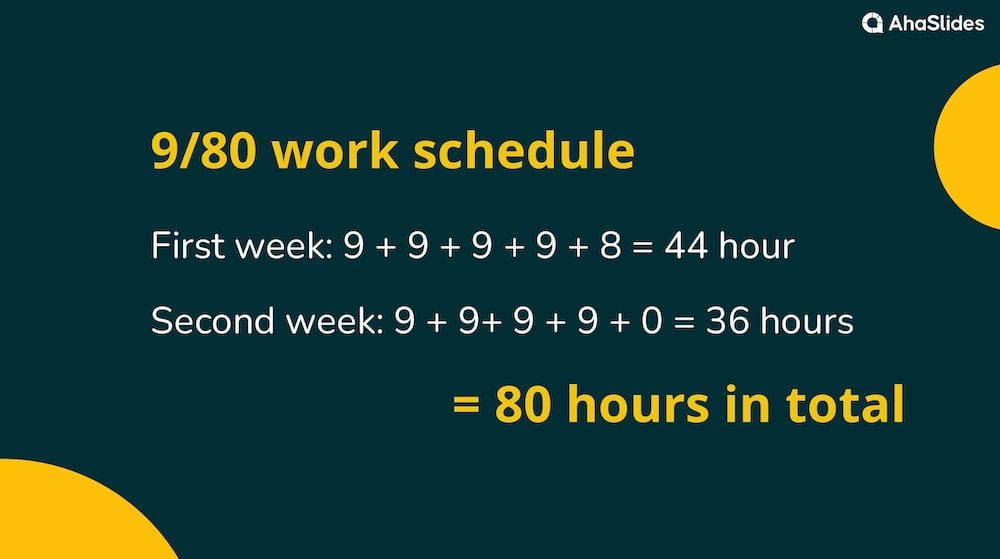Heb je ooit het gevoel gehad dat het klassieke 9-tot-5-schema tegenwoordig gewoon te saai en beperkend is? Nou, je bent niet de enige – veel mensen vinden dat het tijd is voor iets nieuws.
Steeds meer bedrijven beseffen dit en bieden alternatieven voor de normale werkdag van 9 tot 5.
Een optie die steeds populairder wordt, is het 80/9-werkschema.
Weet je niet zeker of het bij jou of je team past? Geen zorgen, we leggen het je graag uit.
We leggen precies uit hoe de 9-80 werkschema werkt, de voor- en nadelen voor zowel werknemers als werkgevers, en of het goed bij uw bedrijf zou kunnen passen.
Inhoudsopgave
- Wat is een 9-80-werkschema?
- Wat is een voorbeeld van een 80-9-werkschema?
- Wat zijn de voordelen van een 9-80-werkschema?
- Potentiële nadelen van een 9-80-werkschema
- Key Takeaways
- Veelgestelde Vragen / FAQ
Tips voor een betere betrokkenheid

Op zoek naar meer plezier tijdens bijeenkomsten?
Verzamel je teamleden voor een leuke quiz op AhaSlides. Meld je aan voor een gratis quiz uit de sjablonenbibliotheek van AhaSlides!
🚀 Grijp gratis quiz☁️
Wat is een 9-80-werkschema?
Een 9/80 werkschema is een alternatief voor de traditionele 9-5, vijfdaagse werkweek waarbij jij in plaats van 8 uur per dag, van maandag tot en met vrijdag, werkt 9 uur per dag werken tijdens een werkperiode van twee weken.
Dit komt neer op 80 uur per twee weken (9 dagen x 9 uur = 81 uur, minus 1 uur overwerk).
Je krijgt elke andere vrijdag vrij als je flex dagDe ene week werk je dus van maandag tot en met donderdag, en de andere week van maandag tot en met vrijdag.
Hierdoor heb je om de week een 3-daags weekend, waardoor je effectief extra vrije tijd krijgt zonder vakantiedagen te gebruiken.
Je rooster is meestal zo ingesteld dat je flexdag in elke betaalperiode op dezelfde dag valt. Hierdoor blijft de consistentie behouden.
De tijdwaarneming volgt nog steeds de standaard 40-urige werkweek regels over overuren. Alles meer dan 8 uur op een dag of 80 uur in een betaalperiode activeert OT.

Wat is een voorbeeld van een 80/9-werkschema?
Hier ziet u een voorbeeld van een 9/80-werkrooster, met elke dag een lunchpauze van een uur:
| Week 1 | Week 2 |
| Maandag 8: 00 - 6: 00 Dinsdag 8: 00 - 6: 00 Woensdag 8: 00 - 6: 00 Donderdag 8: 00 - 6: 00 Vrijdag 8: 00 - 5: 00 | Maandag 8: 00 - 6: 00 Dinsdag 8: 00 - 6: 00 Woensdag 8: 00 - 6: 00 Donderdag 8: 00 - 6: 00 Vrijdag vrije dag |
Enkele veel voorkomende sectoren die gebruik maken van het 9-80-werkschema zijn:
Overheidskantoren – Federale, staats- en lokale instanties bieden hun werknemers vaak een 9-80-regeling aan. Denk bijvoorbeeld aan de Dienst Wegverkeer (DMV), postdiensten en openbare werken.
Gezondheidszorg – Ziekenhuizen willen 7 dagen per week bereikbaar zijn, dus de wisselende vrije vrijdagen helpen daarbij. Kantoorpersoneel, zoals klinieken en laboratoria, maakt hier ook gebruik van.
Nutsbedrijven – Plaatsen zoals waterzuiveringsinstallaties, energiebedrijven, enz. hebben voortdurende monitoring nodig om de dekking te verbeteren.
Productie – Voor 24/7-productieafdelingen zorgt 9/80 voor een goede personeelsbezetting over de diensten heen en biedt het flexibiliteit.
Bel centrales – Klantenservicefuncties sluiten goed aan bij het schema, aangezien de wachttijden kort zijn en er meerdere weekenden zijn.
Rechtshandhaving – Politiebureaus, gevangenissen en gerechtsgebouwen hebben het al vroeg overgenomen om het aan te laten sluiten bij de openingstijden.
Retail – Winkels die in het weekend open zijn, zien dit als een extraatje om hun fulltimewerknemers te behouden.
Vervoer – Van luchtvaartmaatschappijen tot vrachtbedrijven tot de afdeling motorvoertuigen.
Technologie – Startups en technologiebedrijven willen wellicht dit werkschema invoeren om de flexibiliteit te vergroten en talent aan te trekken.
Wat zijn de voordelen van een 9-80-werkschema?
Is een 9-tot-80-werkrooster in uw bedrijf toepasbaar? Overweeg deze voordelen om te zien of het bij u past:
Voor de werknemers

- Om de week vrij – Dit tweewekelijkse schema geeft werknemers om de week een halve dag extra vrij, wat in feite neerkomt op een extra vrije dag per betaalperiode. Dit maakt 3-daagse weekenden of een pauze halverwege de week mogelijk.
- Handhaaf een 40-urige werkweek – Werknemers werken nog steeds 80 uur over de periode van twee weken, zodat ze geen betaalde uren verliezen. Dit kan bijdragen aan een gezonde werk-privébalans.
- Flexibiliteit – Het rooster biedt meer flexibiliteit dan een traditioneel ma-vr-rooster. Medewerkers kunnen afspraken plannen of persoonlijke zaken regelen op hun vrije vrijdag zonder gebruik te maken van verlof.
- Lagere reiskosten – Door om de week vrij te zijn op vrijdag, besparen medewerkers één week op benzine en vervoer. Dit kan hun maandelijkse uitgaven verlagen.
- Verhoogde productiviteit – Sommige studies tonen aan een flexibel uurrooster leidt tot een hogere werktevredenheid en minder burn-out, wat de betrokkenheid en productiviteit van werknemers kan vergroten.
- Meer tijd voor een parttimebaan – Hoewel we het niet aanraden omdat het ten koste kan gaan van je mentale en fysieke gezondheid, biedt de extra vrije dag sommigen de mogelijkheid om een bijbaantje te nemen of parttime te werken om wat extra geld te verdienen.
Voor de Werkgevers

- Hogere productiviteit – Studies tonen aan dat een goed schema stress en burn-outs kan verminderen, wat leidt tot kwalitatief beter werk. Medewerkers kunnen zich beter concentreren en meer betrokken zijn.
- Lagere overheadkosten – Kantoren kunnen om de week op vrijdag gesloten zijn, waardoor u voor die halve dag in de week bespaart op nutsvoorzieningen, onderhoud en andere overheadkosten.
- Talent aantrekken en behouden – Het geeft het bedrijf een voorsprong bij het werven en behouden van toptalenten die waarde hechten aan flexibiliteit op de werkvloer.
- Verbeterde klantenservice – Door extra uren beschikbaar te zijn, kunt u gedurende de werkweek klanten bedienen of afspraken/telefoontjes afhandelen.
- Flexibiliteit in de planning – Managers hebben de flexibiliteit om projecten of opdrachten gedurende de volledige werkuren van elke dag adequaat te bemannen.
- Minder ziekteverzuim – Werknemers zullen waarschijnlijk minder ziektedagen of ongeplande vrije dagen opnemen, omdat ze elders meer tijd hebben ingepland.
- Verbetering van moraal en samenwerking – Meer werkplezier door een beter rooster leidt tot een betere bedrijfscultuur en betere relaties tussen afdelingen.
Potentiële nadelen van een 9-80-werkschema

Voordat u het beleid gaat wijzigen, moet u rekening houden met de andere kanten van dit specifieke werkschema, zoals:
- Administratieve complexiteit – Er is meer coördinatie en planning nodig om dagelijks te zorgen voor voldoende dekking in alle afdelingen.
- Mogelijk gebrek aan personeelsbestand – Er zijn mogelijk niet voldoende medewerkers beschikbaar op de langere werkdagen of de vrije vrijdagen voor bepaalde functies.
- Overwerkkosten – Werknemers die meer dan 8 uur werken op hun geplande langere dagen, moeten overwerkvergoedingen betalen.
- Inflexibiliteit – Het rooster is rigide en laat geen gemakkelijke wisseling van dagen/uren toe als de behoeften veranderen. Mogelijk niet geschikt voor alle functies.
- Urenregistratie – Het is voor managers en salarisadministrateurs lastiger om uren nauwkeurig te registreren in een niet-standaard werkweek. Een gestructureerde implementatie is belangrijk, met een tijdlijn voor aanmeldingen en een overgangsperiode voor coördinatie/communicatie.
- Miscommunicatie – Er is een groter risico op miscommunicatie als de beschikbaarheid van personeel elke twee weken verandert.
- Heeft invloed op samenwerking – Wanneer teams met verschillende schema's werken, kan dit een negatieve impact hebben op de samenwerking en het groepswerk.
- Ongelijkheden – Niet alle banen of functies zijn geschikt voor het rooster, waardoor er ongelijkheden tussen functies ontstaan. Sommige functies, zoals klantenservice, gezondheidszorg of ploegendienst, bieden mogelijk geen flexibiliteit in het rooster.
- Onevenwichtige werklasten – Het kan gebeuren dat het werk ongelijk verdeeld raakt over het tweewekelijkse schema.
- Integratieproblemen – Het kan voor 9/80-personeel een uitdaging zijn om effectief te coördineren met partners volgens een standaard MF-schema.
Key Takeaways
Het 9-80-werkschema biedt meer vrije tijd zonder het loon te verlagen of de uren te verhogen, terwijl een hoge mate van flexibiliteit behouden blijft.
Het biedt bij een goede planning tal van voordelen, maar is mogelijk niet geschikt voor alle sectoren of bedrijfscultuur-/communicatievoorkeuren.
Training op het gebied van planningsspecificaties, zoals tijdregistratie, aanwezigheidsregels en coördinatie met collega's op een standaardrooster, is cruciaal voor het handhaven van een naadloze workflow.
Train effectief, waar en wanneer u ook gaatNieuw beleid heeft tijd nodig om te worden aangenomen. Communiceer uw informatie duidelijk met boeiende peilingen en Q&A.
Veelgestelde Vragen / FAQ
Hoeveel uur is een 9/80 schema per week?
In een 9/80-werkschema werken werknemers 9 uur per dag gedurende 9 dagen in een loonperiode van twee weken.
Wat is een 3 12 werkschema?
Een 3/12-werkschema verwijst naar een rotatie waarbij werknemers gedurende 12 dagen per week in ploegendiensten van 3 uur werken.
Wat is een 9 80-schema in Texas?
Een 9/80-schema werkt in Texas op dezelfde manier als in andere staten. Werkgevers in Texas mogen een 9/80-schema implementeren als een flexibele werkoptie voor werknemers, zolang de regels voor overuren worden nageleefd.
Is een 9 80-schema legaal in Californië?
Werkgevers in Californië mogen alternatieve werkweekschema's zoals 9/80 gebruiken, zolang ze voldoen aan de loon- en urenwetten. Het schema moet via geheime stemming worden aangenomen met ten minste 2/3 van de stemmen van de betrokken werknemers. Dit legitimeert de roosterwijziging.








